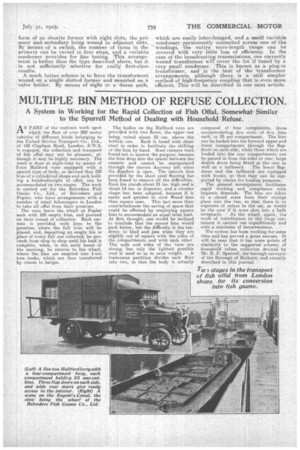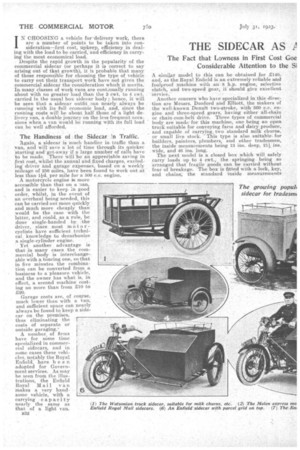MULTIPLE BIN METHOD OF REFUSE COLLECTION.
Page 15

Page 16

If you've noticed an error in this article please click here to report it so we can fix it.
A System in Working for the Rapid Collection of Fish Offal, Somewhat Similar to the Spurrell Method of Dealing with Household Refuse.
AS PART of the contract work upon which the fleet of over 200 motor vehicles of different kinds belonging to the United Service Transport, Co., Ltd., of 14,3 Clapham Road, London, S.W.0, is engaged, the collection and transport of fish offal may not. be pleasant, although it may be highly necessary. The work is done at night-time by means of 5-ton Hanford vans equipped with a special type of body, so devised that 100 bins of a cylindrical shape and each bolding a hundredweight of offal, can be accommodated on two stages. The work is carried out for the Belvedere Fish Guano Co., Ltd., of Belvedere and Poplar, who have arrangements -with a number of retail fishmongers in London to take all offal from their premises.
The vans leave the wharf at Poplar each with 100 empty bins, and proceed on their round of collection. Each carman is provided with keys to the premises where the full bins will be placed, and, depositing an empty bin in place of every full one collected, he proceeds from shop to shop until his load is complete, when, in the early hours ol the morning, he returns to. the wharf, where the bins are emptied into 1-ton iron tanks, which are then transferred by cranes to barges. The bodies on the Rallford vans are provided with two floors, the upper 'one being raised about 28 -ins, above the bottom one. Each is faced with sheet steel in order to facilitate the shifting of the bins by hand. Steel runners were found not to answer the purpose, because the bins drop into the spaces between the runners and cannot be manipulated through the narrow doorway left when the flapdoor is open. The Smooth face provided by the sheet steel flooring has been found to remove all the difficalties. Each bin stands about 21 ins, high and is about 14 ins, in diameter, and a circular shape has been adopted, because it. is easier and quicker to stow &mid bins than square ones. This fact more than counterbalances the saving of space that could be effected by employing square bins to accommodate an equal total load. At, first thought., one would be inclined to conclude that the square bins "Would pack better, but the difficulty is the tendency to bind arid jam when they arc slightly out of. square with the sides of the compartments and with each other The ends and sides of the vans are strong, but only the lightest possible roof is used so as to save weight. A transverse partition divides each floor into two, so that the body is actually
composed . of four components, these ,'accommodating five rows of five bins each, or 25 ner compartment.. The bins can be loaded into the forward upper and lower compartments through the flapdoors on each tide, while those which are leaded into the rear compartments can be passed in from the sides or rear, large double doors being fitted, at the rear as
well as a tailboard. The lower flapdoors and the tailboard are equipped with hooks, so that they can be supported by chains for loading purposes.
The general arrangement facilitates rapid working and compliance with hygienic demands. The bins are taken in a closed state from their storage place into the van; so that there is, no exposure of refuse to thi air, as would be the case' if it. were shot into a bulk
receptacle. At the wharf, again, the work of transference to the large containers. is carried out expeditiously and with a minimnin of inconvenience.
The system has been working for some time and has proved a great success. It will be seen that it has some points of similarity to the suggested scheme, of household refuse collection devised by Mr. E. F. Spurrell, the borough surveyor of the Borough of Rolborn, and recently described in this journal,
IN CHOOSING a vehicle for 'delivery work, there are a number of points to be taken into consideration—first cost, upkeep, efficiency in dealing with the load to be carried, and efficiency in carrying the most economical load. Despite the rapid growth in the popularity of the commercial sidecar (or perhaps it is correct to say arising out of that growth), it is probable that many of those responsible for choosing the type of vehicle to carry out their transport work have not given the commercial sidecar the consideration which it merits. In. many classes of work vans are continually running about with no greater load than the 3 cwt. to 4 cwt. carried in the usual box sidecar body; hence, it will be seen that a sidecar outfit can nearly always be running with its full economic load, and, since the running costs will be about half those. of a light delivery van, a double journey on the less frequent occasions when a van would be running with its full load
can be well afforded. .
The Handiness of the. Sidecar. n Traffic.
'Againa sidecar is much handier in traffic than a
z . . van, and will save a lot Of time through its quicker starting And' get-away if a large number of calls have to be Made. . There -will be an appre6iable saving in first cost, whilst the annual and fixed charges, exclud, ;
frig' driver and garage' expenses, based on a weekly mi. cage of 250 miles, have been found to work out at less than lid. per mile for a 500 c.c. engine. .
A motorcycle engine'is more accessible than that on a 7; an,
and is easier to keep n good order, whilst, in the event of an overhaul being needed, this can be carried eat more quickly and much more -cheaply than would be the 'case with the latter, and could, as a rule, be done single-handed by, the driver, since most motor. cyclists have sufficient technical knowledge to decarbonize a single-cylinder engine. Yet another advantage is that in many cases the commercial body is interchangeable with a touring one, so that in five minutes the combination can be converted from a business to a pleasure vehicle, and the owner has what is, in effect, a second machine costing no more than from 110 to £20. Garage costs are, of course, much lower than with a. van, and sufficient space can nearly always be found to keep a sidecar on the premises, thus eliminating the costs of separate or outside garaging.*
A number, of firms have for some time specialized in commercial sidecars, and in some cases these vehicles notably the Royal Enfield, have been adopted for Government services. As may be. seen from the illustrations, the Enfield Royal Mail van makes a very handsome vehicle, with a carrying capacity nearly the same as that of a light van.






























